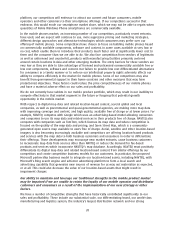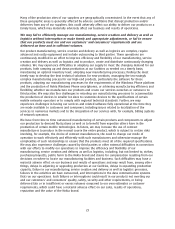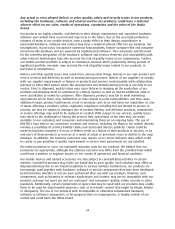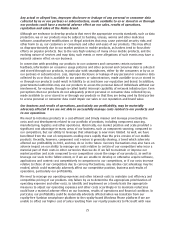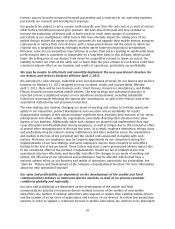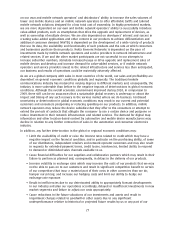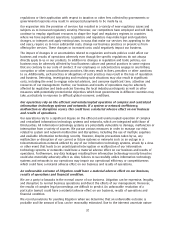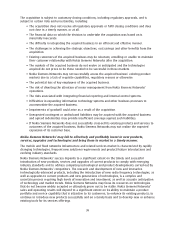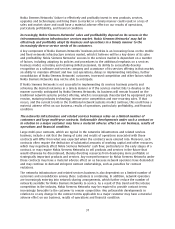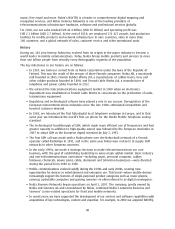Nokia 2010 Annual Report Download - page 31
Download and view the complete annual report
Please find page 31 of the 2010 Nokia annual report below. You can navigate through the pages in the report by either clicking on the pages listed below, or by using the keyword search tool below to find specific information within the annual report.Nokia Siemens Networks has access to certain licenses through crosslicensing arrangements with its
current shareholders, Nokia and Siemens. If there are changes to Nokia Siemens Networks’ corporate
structure, including a sale of Nokia Siemens Networks’ shares by one or both of its current
shareholders, Nokia Siemens Networks may be unable to rely on some of its existing licenses. There
can be no assurance that such licenses could be replaced on terms that are commercially acceptable.
We make accruals and provisions to cover our estimated total direct IPR costs for our products. The
total direct IPR cost consists of actual payments to licensors, accrued expenses under existing
agreements and provisions for potential liabilities. We believe that our accruals and provisions are
appropriate for all technologies owned by others. The ultimate outcome, however, may differ from
the provided level which could have a positive or negative impact on our results of operations and
financial condition.
Any restrictions on our ability to sell our products due to expected or alleged infringements of third
party intellectual property rights and any intellectual property rights claims, regardless of merit, could
result in material losses of profits, costly litigation, the payment of damages and other compensation,
the diversion of the attention of our personnel, product shipment delays or the need for us to
develop noninfringing technology or to enter into a licensing agreement. If licensing agreements
were not available or available on commercially acceptable terms, we could be precluded from
making and selling the affected products, or could face increased licensing costs. As new features are
added to our products, we may need to acquire further licenses, including from new and sometimes
unidentified owners of intellectual property. The cumulative costs of obtaining any necessary licenses
are difficult to predict and may over time have a negative effect on our operating results. See
Item 4B. “Business Overview—Devices & Services—Patents and Licenses”; “—NAVTEQ—Patents and
Licenses” and “—Nokia Siemens Networks—Patents and Licenses” for a more detailed discussion of
our intellectual property activities.
Our products include numerous Nokia, NAVTEQ and Nokia Siemens Networks patented,
standardized or proprietary technologies on which we depend. Third parties may use without
a license or unlawfully infringe our intellectual property or commence actions seeking to
establish the invalidity of the intellectual property rights of these technologies. This may have
a material adverse effect on our business and results of operations.
Our products include numerous Nokia, NAVTEQ and Nokia Siemens Networks patented, standardized
or proprietary technologies on which we depend. Despite the steps that we have taken to protect our
technology investment with intellectual property rights, we cannot be certain that any rights or
pending applications will be granted or that the rights granted in connection with any future patents
or other intellectual property rights will be sufficiently broad to protect our technology. Third parties
may infringe our intellectual property relating to our nonlicensable proprietary features or by
ignoring their obligation to seek a license.
Any patents or other intellectual property rights that are granted to us may be challenged, invalidated
or circumvented, and any right granted under our patents may not provide competitive advantages
for us. Other companies have commenced and may continue to commence actions seeking to
establish the invalidity of our intellectual property, for example, patent rights. In the event that one
or more of our patents are challenged, a court may invalidate the patent or determine that the
patent is not enforceable, which could harm our competitive position. Also, if any of our key patents
are invalidated, or if the scope of the claims in any of these patents is limited by a court decision, we
could be prevented from using such patents as a basis for product differentiation or from licensing
the invalidated or limited portion of our intellectual property rights, or we could lose part of the
leverage we have in terms of our own intellectual property rights portfolio. Even if such a patent
challenge is not successful, it could be expensive and timeconsuming, divert attention of our
management and technical personnel from our business and harm our reputation. Any diminution of
the protection that our own intellectual property rights enjoy could cause us to lose some of the
benefits of our investments in research and development, which may have a negative effect on our
30


